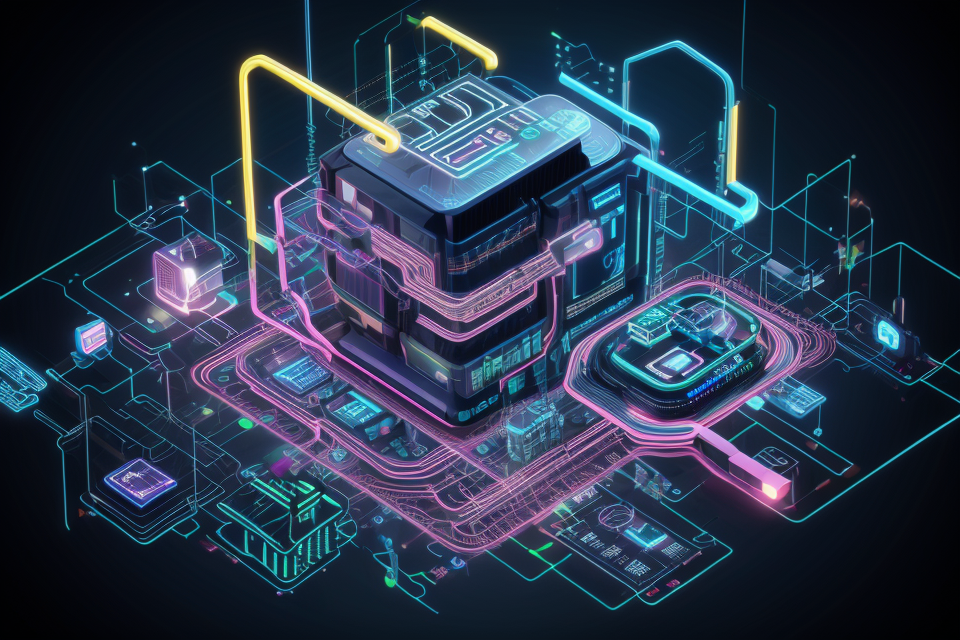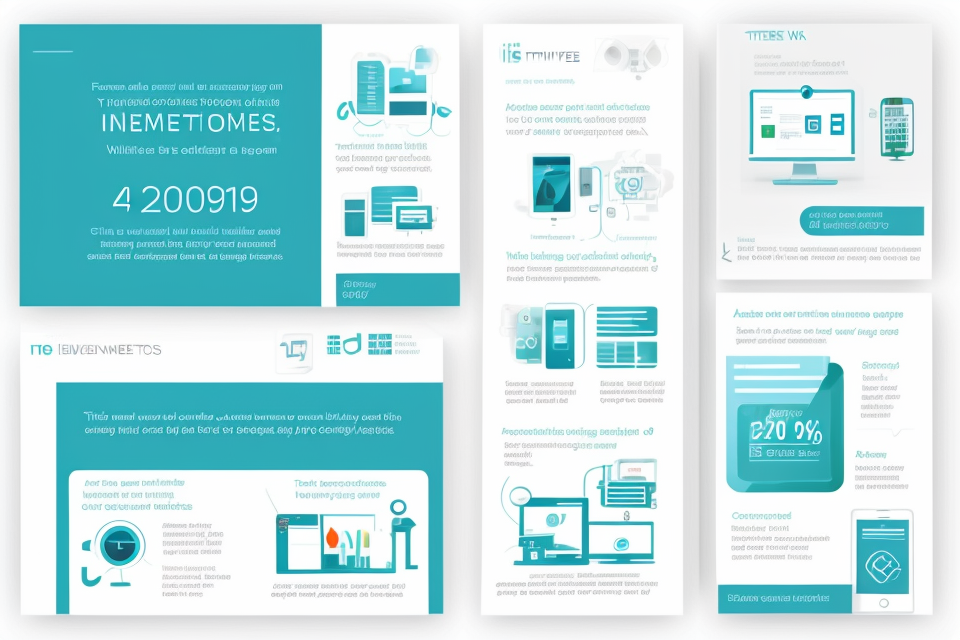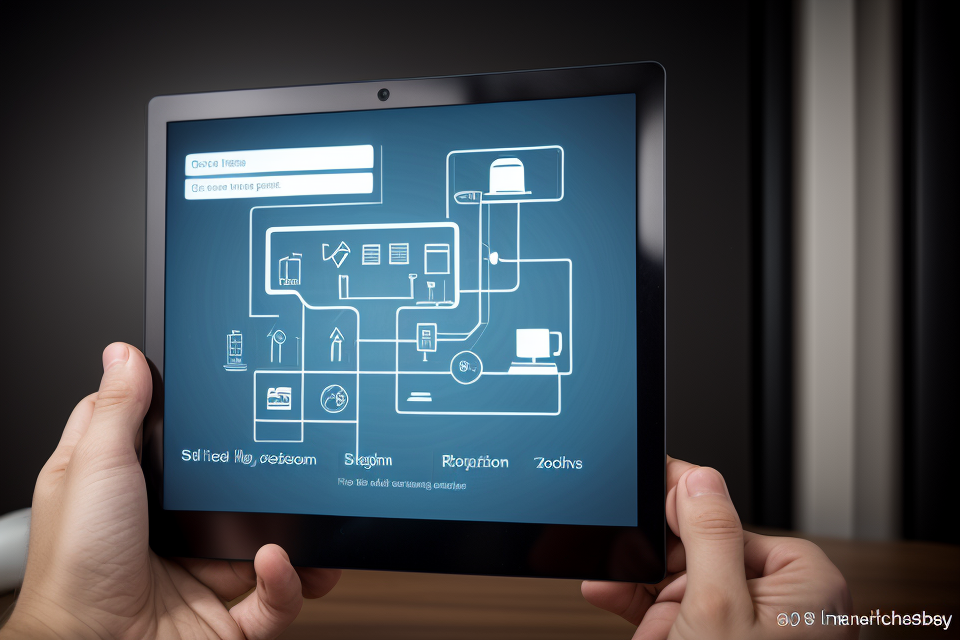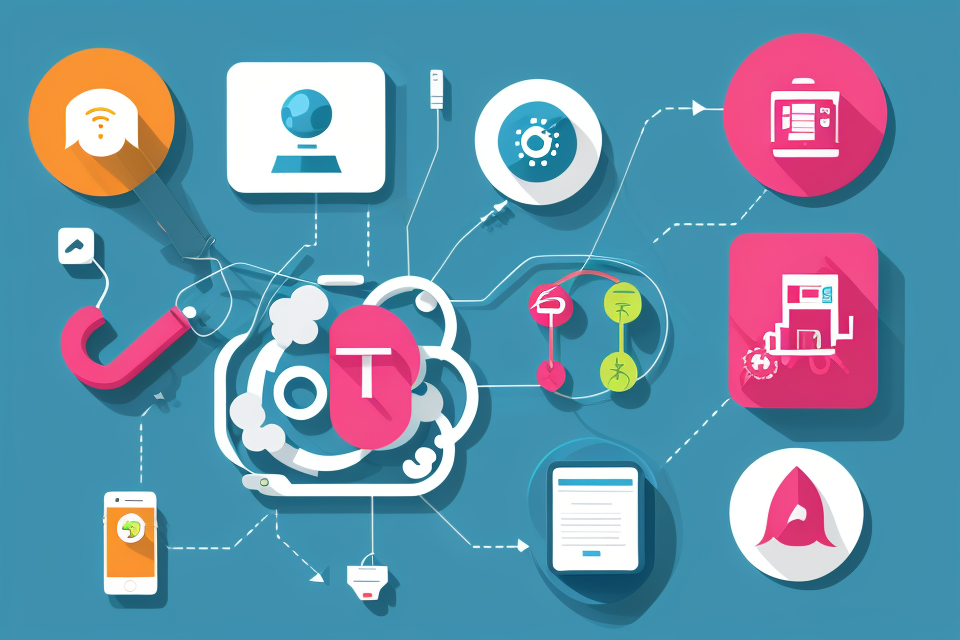The Internet of Things (IoT) is a network of physical devices, vehicles, home appliances, and other items embedded with sensors, software, and connectivity which enables these objects to connect and exchange data. IoT technology allows for seamless communication between devices, creating a connected ecosystem that makes our lives easier and more efficient. With IoT, everyday objects can be turned into smart devices that can be controlled and monitored remotely. From smart homes to smart cities, IoT is revolutionizing the way we live and work. In this article, we will explore what IoT is, how it works, and its potential applications. So, buckle up and get ready to dive into the world of IoT!
The Internet of Things (IoT) refers to the network of physical devices, vehicles, home appliances, and other items embedded with electronics, software, sensors, and connectivity which enables these objects to connect and exchange data. IoT allows these devices to be remotely monitored and controlled, making it possible to automate tasks and improve efficiency. IoT works by collecting data from sensors embedded in devices and sending that data to a cloud-based platform for analysis. The data is then used to make decisions and take actions, such as adjusting the temperature of a smart thermostat or sending alerts if a sensor detects an anomaly. Essentially, IoT allows devices to talk to each other and make decisions based on the data they collect, making it a powerful tool for improving efficiency and productivity in a variety of industries.
What is the Internet of Things (IoT)?
IoT Definition
The Internet of Things (IoT) refers to the interconnection of physical devices, vehicles, buildings, and other objects, which are embedded with sensors, software, and network connectivity, enabling them to collect and exchange data. In essence, IoT is a system of systems, where each device or object is a node in the network, communicating with other nodes to facilitate data exchange and processing.
IoT Components
The Internet of Things comprises several key components that work together to enable the seamless exchange of data between connected devices. These components include:
- IoT devices: These are physical objects or devices that are embedded with sensors, software, and network connectivity, allowing them to collect and exchange data. Examples of IoT devices include smart home appliances, wearable technology, and connected vehicles.
- IoT platforms: These are software frameworks that provide the necessary infrastructure for IoT devices to communicate with each other and with other systems. IoT platforms offer features such as data collection, storage, and analysis, as well as device management and security.
- IoT networks: These are the communication systems that enable IoT devices to connect and exchange data. IoT networks can be wired or wireless, and they use various protocols and standards to ensure seamless communication between devices.
- IoT data: This refers to the data that is generated by IoT devices as they collect and exchange information. IoT data can include sensor readings, location information, and other contextual data, and it can be analyzed to generate insights and drive decision-making.
How Does IoT Work?
IoT Device Connectivity
The Internet of Things (IoT) relies on the connectivity of devices to the internet. IoT devices can connect to the internet through various communication protocols, such as Wi-Fi, Bluetooth, and cellular networks. Wi-Fi is a popular choice for IoT devices in homes and offices, providing wireless connectivity to devices within range. Bluetooth is often used for short-range connections between devices, such as smart home devices and smartphones. Cellular networks, such as 4G and 5G, provide wider coverage and are used for IoT devices that require mobile connectivity, such as connected cars and remote sensors.
IoT Data Collection
IoT devices collect data from their surroundings through sensors. Sensors can measure various parameters such as temperature, humidity, and motion. The data collected by these sensors is used to gain insights into the behavior of the device or the environment it is in. For example, a smart thermostat may use sensors to measure the temperature in a room and adjust the heating or cooling accordingly.
IoT Data Processing
Once the data is collected, it needs to be transmitted to IoT platforms for processing and analysis. IoT platforms are responsible for receiving and processing the data collected by IoT devices. These platforms use algorithms and machine learning techniques to analyze the data and generate insights. The insights generated can be used to optimize processes, improve efficiency, and make informed decisions. For example, an IoT platform for a factory may use data from sensors to identify inefficiencies in the production process and suggest improvements.
IoT Data Analysis
IoT platforms use algorithms and machine learning techniques to analyze the data and generate insights. The insights generated can be used to optimize processes, improve efficiency, and make informed decisions. For example, an IoT platform for a smart city may use data from sensors to optimize traffic flow, reduce congestion, and improve public safety. The insights generated by IoT platforms can also be used to identify patterns and trends, allowing businesses and organizations to make data-driven decisions.
In summary, IoT devices connect to the internet through various communication protocols, collect data from their surroundings through sensors, transmit the data to IoT platforms for processing and analysis, and generate insights that can be used to optimize processes, improve efficiency, and make informed decisions.
Applications of IoT
Smart Homes
The Internet of Things (IoT) has revolutionized the way we live and interact with our homes. One of the most prominent applications of IoT is in smart homes, where various devices and systems are connected and can communicate with each other to create a more efficient and convenient living environment.
Benefits of Smart Homes
Smart homes offer a range of benefits, including:
- Energy Efficiency: Smart homes can help reduce energy consumption by automatically adjusting lighting, heating, and cooling systems based on occupancy and environmental conditions.
- Enhanced Security: IoT-enabled security systems can detect intruders, monitor activity, and send alerts to homeowners or law enforcement agencies in case of emergencies.
- Improved Convenience: Smart homes allow homeowners to control various devices and systems remotely, such as adjusting the thermostat, locking doors, or turning off lights, making their lives more comfortable and convenient.
Components of Smart Homes
A typical smart home consists of several components, including:
- Sensors: These are devices that detect and measure various environmental conditions, such as temperature, humidity, and motion.
- Actuators: Actuators are devices that can be controlled to perform specific actions, such as turning on a light or adjusting the thermostat.
- Connectivity: Smart homes rely on wireless connectivity to enable communication between devices and systems.
- Controllers: Controllers are devices that manage and coordinate the interactions between sensors, actuators, and other smart home devices.
Use Cases for Smart Homes
Some examples of how smart homes can be used include:
- Vacation Mode: Smart homes can be programmed to conserve energy and manage security while the homeowners are away.
- Aging in Place: IoT-enabled devices can help elderly or disabled individuals live independently by providing assistance with daily tasks and monitoring their safety.
- Remote Management: Smart homes can be managed remotely through smartphone apps or voice assistants, allowing homeowners to control their homes from anywhere.
Overall, smart homes represent one of the most exciting and practical applications of the Internet of Things, and as technology continues to advance, we can expect to see even more innovative uses for these connected devices and systems.
Industrial IoT
How IoT is Revolutionizing Industrial Operations
Industrial IoT (IIoT) refers to the integration of IoT technology into industrial settings, such as manufacturing plants, to enhance productivity, reduce downtime, and improve safety. By leveraging IIoT, businesses can optimize their operations, increase efficiency, and reduce costs.
Key Components of IIoT
IIoT involves several components that work together to enable the seamless integration of IoT devices and systems in industrial settings. These components include:
- Sensors: Sensors are used to collect data from machines, equipment, and other devices in the industrial setting. These sensors can monitor various parameters, such as temperature, pressure, and vibration, to ensure optimal performance.
- Connectivity: IIoT devices rely on wireless connectivity to transmit data between devices and systems. Technologies such as Wi-Fi, Bluetooth, and cellular networks are commonly used to enable connectivity in industrial settings.
- Data Analytics: IIoT generates vast amounts of data, which must be analyzed to derive insights and make informed decisions. Advanced analytics tools are used to process this data, identify patterns, and generate actionable insights.
- Cloud Computing: Cloud computing plays a critical role in IIoT by providing a scalable and secure platform for data storage, processing, and analysis. Cloud-based solutions enable businesses to access data from anywhere, at any time.
Use Cases of IIoT in Industrial Settings
IIoT has numerous use cases in industrial settings, including:
- Predictive Maintenance: IIoT devices can monitor equipment performance and predict potential failures, enabling businesses to schedule maintenance activities before breakdowns occur. This proactive approach can reduce downtime and extend the lifespan of equipment.
- Quality Control: IIoT can be used to monitor product quality during manufacturing processes, ensuring that products meet quality standards and reducing the risk of defects.
- Supply Chain Management: IIoT can improve supply chain management by providing real-time visibility into inventory levels, transportation, and delivery times. This information can help businesses optimize their supply chain operations and reduce costs.
- Workplace Safety: IIoT can be used to monitor workplace safety by detecting potential hazards and alerting workers to potential risks. This can help businesses reduce accidents and improve safety in the workplace.
In conclusion, IIoT has the potential to revolutionize industrial operations by enabling businesses to optimize their processes, reduce downtime, and improve safety. By leveraging IIoT technology, businesses can gain a competitive edge and drive growth in their respective industries.
Healthcare IoT
Monitoring Patient Conditions
The Internet of Things (IoT) can be utilized in healthcare to monitor patient conditions in real-time. This can include vital signs such as heart rate, blood pressure, and oxygen saturation levels. By collecting and analyzing this data, healthcare providers can quickly identify any changes in a patient’s condition and take appropriate action.
Remote Management of Chronic Diseases
IoT technology can also be used to remotely manage chronic diseases such as diabetes, asthma, and heart disease. By using wearable devices and sensors, patients can track their symptoms and share the data with their healthcare providers. This allows for more proactive and personalized care, which can improve patient outcomes and reduce healthcare costs.
Improving Healthcare Delivery Efficiency
In addition to improving patient care, IoT technology can also be used to improve the efficiency of healthcare delivery. This can include automating tasks such as medication management and inventory tracking, as well as improving communication and collaboration among healthcare providers. By streamlining these processes, healthcare providers can focus more on providing high-quality care to their patients.
Challenges and Limitations of IoT
Security and Privacy Concerns
As the Internet of Things (IoT) continues to expand and become more integrated into our daily lives, it brings with it a range of benefits and opportunities. However, there are also several challenges and limitations that must be addressed in order to ensure the successful adoption and implementation of IoT technology. One of the most significant challenges is the issue of security and privacy concerns.
IoT devices are often equipped with sensors and software that allow them to collect and transmit data about their environment and the activities they are involved in. This data can include personal information, such as location, health, and behavior, as well as sensitive information, such as financial transactions and confidential business data. As a result, IoT devices can be vulnerable to cyber-attacks, which can compromise the security and privacy of the data they collect and transmit.
One of the main concerns is that many IoT devices are not designed with security in mind, and are therefore easily hackable. This is due in part to the fact that many IoT devices are developed and manufactured quickly, in order to meet the demands of a rapidly growing market. As a result, many IoT devices are released with little or no security measures in place, making them vulnerable to attack.
Another concern is that IoT devices are often connected to the internet, which means that they can be accessed remotely by hackers. This makes it possible for hackers to gain access to the data that is being collected and transmitted by the device, as well as to control the device itself. This can have serious consequences, such as allowing hackers to access sensitive information, disrupt business operations, or even cause physical harm.
To address these security and privacy concerns, it is important to implement robust security measures and best practices when developing and deploying IoT devices. This includes ensuring that devices are securely designed and manufactured, as well as providing regular updates and patches to address any known vulnerabilities. It is also important to raise awareness among users about the importance of security and privacy, and to provide them with the tools and resources they need to protect themselves and their data.
Overall, security and privacy concerns are a significant challenge for the Internet of Things, but with the right measures and best practices in place, it is possible to mitigate these risks and ensure the safe and secure adoption of IoT technology.
Interoperability Issues
One of the major challenges in IoT is interoperability, which refers to the ability of different devices and systems to work together seamlessly. This is a significant issue because IoT devices often use different communication protocols and standards, which can make it difficult to integrate them into existing systems.
There are several reasons why interoperability is a challenge in IoT:
- Diversity of devices: IoT devices come in all shapes and sizes, from simple sensors to complex machines, and each device may have its own unique communication protocols and standards.
- Lack of standardization: Despite efforts to create industry standards, there is still a lack of standardization in the IoT industry, which can lead to compatibility issues between devices.
- Security concerns: As IoT devices become more integrated into our daily lives, security becomes a critical concern. Devices that are not designed to work together can create vulnerabilities in the system, making it easier for hackers to gain access to sensitive information.
To address these challenges, there are several approaches that can be taken:
- Using open standards: By using open standards, devices from different manufacturers can communicate with each other seamlessly, regardless of their underlying communication protocols.
- Device management platforms: These platforms provide a centralized point of control for managing IoT devices, making it easier to integrate new devices into existing systems.
- Security protocols: Implementing security protocols such as encryption and authentication can help to protect IoT devices from cyber-attacks and ensure that sensitive information is kept secure.
In conclusion, interoperability is a significant challenge in IoT, but with the right approaches, it is possible to overcome these challenges and create a more connected and integrated world.
Data Management and Analytics
As the number of IoT devices continues to grow, so does the amount of data they generate. This data can include sensor readings, user behavior, and machine-to-machine communication. While this data can be valuable for businesses and organizations, managing and analyzing it can be a significant challenge.
Volume of Data
One of the main challenges of IoT data is the sheer volume of it. IoT devices can generate vast amounts of data, which can quickly become overwhelming. This data must be stored and processed in a way that is efficient and scalable.
Data Quality
Another challenge is ensuring the quality of the data. IoT devices can be prone to errors and inconsistencies, which can affect the accuracy of the data. It is essential to have processes in place to detect and correct these issues to ensure that the data is reliable.
Data Security
Data security is also a critical concern when it comes to IoT data. As IoT devices are often connected to the internet, they can be vulnerable to cyber attacks. It is essential to have robust security measures in place to protect the data and prevent unauthorized access.
Data Analysis
Once the data has been collected and stored, it must be analyzed to extract insights and inform decision-making. This can be a significant challenge, as the data may be unstructured and complex. It is essential to have the right tools and expertise to analyze the data effectively.
Real-Time Processing
IoT data is often time-sensitive, and it is essential to process it in real-time to be useful. This can be a challenge, as the data may be coming in at a high rate of speed. It is necessary to have systems in place that can handle real-time processing and analysis.
Overall, managing and analyzing IoT data can be a significant challenge, but it is essential for businesses and organizations to harness the value of this data. By addressing the challenges and limitations of IoT data, companies can unlock new insights and drive innovation.
Infrastructure and Connectivity
Lack of Infrastructure in Remote Areas
One of the significant challenges faced by IoT is the lack of infrastructure in remote areas. Many remote areas have limited or no access to internet connectivity, which makes it difficult for IoT devices to function effectively. In such areas, the deployment of IoT devices may require the installation of new communication infrastructure, which can be costly and time-consuming.
Limited Connectivity in Underserved Areas
Underserved areas are those that have limited access to internet connectivity due to various reasons such as lack of infrastructure, affordability, or geographical barriers. In such areas, IoT devices may not work effectively due to limited connectivity. This can be a significant challenge for businesses that want to deploy IoT devices in these areas.
Interference and Coverage Issues
IoT devices rely on wireless communication to transmit data, and this can be affected by interference from other devices or physical barriers such as walls or mountains. This can result in poor coverage, which can affect the performance of IoT devices. Additionally, IoT devices may require multiple network connections to ensure reliable communication, which can be challenging in areas with limited connectivity.
Power Supply Challenges
IoT devices are often battery-powered, and the limited battery life can be a significant challenge for IoT deployment. The power supply to these devices can be unreliable, and the devices may require frequent battery replacements, which can be expensive and time-consuming. Additionally, IoT devices may require significant amounts of power to function effectively, which can be a challenge in areas with limited power supply.
In conclusion, infrastructure and connectivity are significant challenges faced by IoT deployment. IoT devices require reliable internet connectivity and infrastructure to function effectively, which can be a challenge in remote or underserved areas. Interference and coverage issues, limited connectivity, and power supply challenges are some of the significant challenges faced by IoT deployment.
FAQs
1. What is the Internet of Things (IoT)?
The Internet of Things (IoT) refers to the network of physical devices, vehicles, buildings, and other items embedded with sensors, software, and connectivity to enable these objects to collect and exchange data. In simpler terms, IoT is a system of interconnected physical devices, which can gather and share data over the internet, without requiring human intervention.
2. How does IoT work?
IoT devices typically consist of three main components: sensors, a microcontroller, and a communication module. The sensors collect data from the environment, the microcontroller processes this data, and the communication module transmits it to other devices or to the cloud. The data is often analyzed using machine learning algorithms to extract insights and inform decision-making. The communication between devices can be direct, through a local network, or indirect, via the internet.
3. What are some examples of IoT devices?
Examples of IoT devices include smart home appliances (such as thermostats and lighting systems), wearable technology (like smartwatches and fitness trackers), connected cars, and industrial equipment with sensors to monitor performance and maintenance needs. In the healthcare sector, IoT devices can include medical monitors and implantable devices that transmit data to healthcare providers for analysis and treatment.
4. How does IoT impact our daily lives?
IoT has the potential to greatly improve our daily lives by providing convenience, efficiency, and safety benefits. For example, smart home automation can make our homes more energy-efficient and secure, while wearable technology can help us monitor our health and fitness more effectively. IoT can also be used in transportation to improve traffic management, enhance public safety, and optimize energy consumption in vehicles.
5. What are some potential risks or challenges associated with IoT?
As with any technology, there are potential risks and challenges associated with IoT. These can include data privacy and security concerns, as IoT devices often collect and transmit sensitive information. There is also the risk of device malfunction or hacking, which could lead to system failures or unauthorized access to personal data. Additionally, IoT devices may have limited battery life, which can be a challenge for devices that are difficult to replace or recharge.
6. How can businesses benefit from IoT?
Businesses can benefit from IoT in various ways, including improved operational efficiency, enhanced customer experiences, and new revenue streams. For example, IoT can be used to optimize supply chain management, enhance product quality control, and improve inventory management. In the consumer space, IoT can be used to offer personalized services and products, as well as to gather valuable customer insights. Additionally, IoT can enable new business models, such as subscription-based services, and create opportunities for data monetization.



